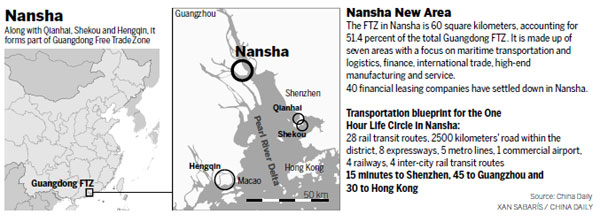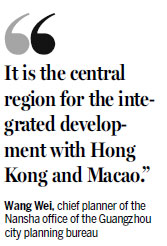Nansha to spearhead financial reforms, service sector growth, green urbanization in Guangdong
By 2017, it will take only 30 minutes to go from Nansha, which lies at the estuary of the Pearl River, to Hong Kong or Macao.
The area is improving its transportation infrastructure now that it has been designated as part of the China (Guangdong) Pilot Free Trade Zone.
Nansha, a southern coastal district of Guangzhou, the capital city of Guangdong province, is 70 kilometers from Hong Kong, 89 km from Macao and 111 km from downtown Guangzhou. With an area of 783 sq km, similar to Hong Kong or Singapore, it is located in the center of the Pearl River Delta Region, a major coastal economic center adjacent to the Yangtze River Delta Region.
Within the district, 60 sq km comprising seven separate sites have been designated as part of the Guangdong FTZ, which was approved by the State Council last December as one of the nation's four FTZs.
Nansha FTZ is the largest area among the three regions that form the Guangdong FTZ. The other two are Hengqin Island in Zhuhai and Qianhai in Shenzhen, with geographical proximity to Nansha.
"The positioning of Nansha as part of the Guangdong FTZ is that it will be built into the central business district in the Pearl River Delta Region connecting ... Guangdong, Hong Kong and Macao," said Wang Wei, chief planner of the Nansha office of the Guangzhou city planning bureau.
According to Wang, 120 km of high-speed roads have already been completed, out of 200 km in the development plan of Nansha. Those roads include a ring road around Guangzhou, one that connects the area with Hong Kong and Macao, and a highway-rail bridge connecting Shenzhen and Maoming.
"The Nansha zone is going to be the experimental area of Guangdong's endeavor in industrial modernization, financial reform, service industry development and environment-oriented urbanization," noted Wang. "In particular, it is the central region for the integrated development with Hong Kong and Macao."
"By 2017, when most of the transportation routes have been built, it will take only half an hour to go from Nansha to Hong Kong or Macao," said Wang.
Jiaomenhe, an area in central Nansha that covers a mere 3 sq km, will be the service center for foreign investment in the FTZ. A total of 5 million square meters of floor space has been planned for companies' headquarters, particularly small and medium-sized enterprises.
"In my view, an FTZ should just be like Hong Kong," said Wu Yunyuan, the owner of an Australian wine import company, which registered in Nansha right after the Guangdong FTZ was approved by the central government in December 2014.
"One of the biggest attractions of Hong Kong is its duty-free products. I believe Nansha will soon offer duty-free products too," said Wu. "Moreover, I appreciate the efficiency of the FTZ in administration. It took only one workday for me to change my company's main business from wine import from various countries to exclusively from Australia."
The Nansha Harbor in the north, measuring 5 sq km, was originally developed in the 1990s by the late Henry Fok Ying-tung, a Hong Kong tycoon, into a leisure service area. The harbor has 300 yacht berths, and two cruise home ports are being planned.
According to Wang, the establishment of the Guangdong FTZ is driving demand for the office buildings under construction in Nansha.
"We noted surges in property sales in Nansha last November and December," said He Ling, head of the market research department of Savills Property Services (Guangzhou) Co.
"The FTZ is definitely going to benefit the housing market in Nansha in the long run if the planning and development are well implemented."
Guangdong is the first province that released a general development plan within the framework of the national "One Belt, One Road" strategy. The plan lists more than 10 projects for the first three years starting from 2015, including the construction of a power plant in Vietnam and metals investments in Australia.
"Nansha will benefit from the 'One Belt, One Road' strategy not in terms of economic growth but in terms of experiments that will be able to be carried out in the district," said Guangzhou Mayor Chen Jianhua.
The GDP of Nansha last year was 100 billion yuan ($16.3 billion), accounting for only one-17th of the overall GDP of Guangzhou province.
"However, it plays a crucial role in the province's economic modernization, particularly now that (there is) an FTZ. The new economic rules, the business environment, the transformation of industry and the introduction of international standards practiced in Nansha, if successful, will be quickly promoted in the rest of Guangdong province," said Chen.
Contact the writers at yangziman@chinadaily.com.cn and zhangyuan@chinadaily.com.cn


(China Daily USA?05/04/2015 page13)
Guadalupe, a 55-year-old lady living in Spain, has been practicing tai chi for almost 20 years. She believes tai chi is not only a kind of martial art but a complete system of fusing traditional Chinese culture.

One of the potentially most traumatic things a girl has to go through is finding a new hairdresser.